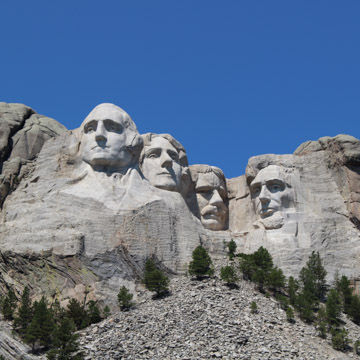Mount Rushmore National Memorial is South Dakota’s most famous landmark. The nearly 1,300-acre park is located in the Black Hills near the town of Keystone, in an area characterized by rugged terrain and a forest of pine, spruce, aspen, and oak. The colossal monument, comprising the 60-foot-high heads of presidents George Washington, Thomas Jefferson, Abraham Lincoln, and Theodore Roosevelt, is carved across 250 feet of a granite ridge.
In the early 1920s, South Dakota state historian Doane Robinson first conceived of a monument to promote tourism in the region. He persuaded sculptor Gutzon Borglum, who was initially involved in sculpting the massive Confederate Memorial bas-relief carving on Stone Mountain in Georgia, to come to the Black Hills to determine what kind of monument could be built. Robinson had originally selected a set of granite pillars known as the Needles to be the site of the monument, from which he envisioned carving the likenesses of Western figures such as Red Cloud, Buffalo Bill Cody, and Lewis and Clark, but Borglum rejected the site due to the fragility of the pillars.
Borglum selected the current monument’s location for its grander location, southern exposure, and more substantial surface for carving. Known to the Lakota Sioux as Six Grandfathers, the mountain, and indeed all of the Black Hills, are sacred territory for the land’s original occupants. The land had been promised in perpetuity to the Lakota Sioux in an 1868 treaty, but the U.S. government took over the area after gold was discovered there in the 1870s. The monument received Congressional approval in 1925, but work did not begin until 1927, when federal funds were secured.
Borglum also selected the monument’s subject matter. Wanting to create a memorial to American development, Borglum chose the four presidents he felt symbolized the most important events in U.S. history: George Washington represents the birth of the country; Jefferson, who doubled the size of the nation with the 1803 Louisiana Purchase, represents the country’s physical growth; Lincoln represents the preservation of the country; and Roosevelt represents industrial and economic growth. In Borglum’s original design, the presidents were to be depicted from head to waist but insufficient funding altered the plans. The order and placement of the faces also changed due to the nature of the granite.
Work on the project continued off and on through the 1930s, with a labor force of nearly 400 people. Workers climbed 700 stairs to reach the top of the mountain, where they were lowered down in bosun’s chairs suspended by 3/8-inch-thick steel cables. Dynamite blasted away much of the rock face until three to six inches was left for the final carving surface. Drillers and carvers then honeycombed the surface, drilling closely spaced holes that weakened the granite so that it could be removed by hand. The surfaces were then smoothed using a hand facer or bumper tool. Borglum appointed Luigi del Bianco chief carver in 1935. In 1938, Borglum began construction on the Hall of Records in a valley behind the sculpture, which he intended to serve as a large repository of archival material relating to the history of the country and of the monument; it was never completed due to insufficient funding. Borglum also built an L-shaped Sculptor’s Studio east of the sculpture in 1939, which displays his original plaster models. After Borglum’s death in 1941, his son Lincoln supervised the completion of the project.
In 1933, the National Park Service (NPS) assumed ownership of Mount Rushmore. By the 1950s, the site had become a popular tourist attraction, and in 1957, the NPS developed the property to include visitor services as part of its Mission 66 program. In addition to a modernist visitors’ center designed by Harold Spitznagel and Cecil Doty, other facilities included a restaurant, gift shop, an amphitheater southeast of the sculpture, and an open-air stone viewing terrace. By the 1990s, visitation reached nearly 3 million people a year, and the site was completely redeveloped to accommodate the tourists, most of whom arrived by private automobile.
The 1990s renovation reflected a design shift from 1950s modernism to late-twentieth-century postmodernism, and the original visitors’ center, restaurant, and gift shop were demolished to make room for a more cohesive approach to the sculpture. Visitors park their cars in the one of the two triple-deck parking lots to the southwest. (While there is no admission fee for the site, visitors must pay to park). Landscaped pathways between the parking lots lead to a 17-bay rectangular arcade inscribed with the monument’s name, which marks the main entrance. Just beyond the arcade are two boxy, one-story buildings housing the information center and restrooms/audio tours, respectively. A wide walkway with granite pavers leads past a gift shop and a concession stand, which are connected via another rectangular arcade. Beyond this is the Avenue of Flags, installed in 1976. State, district, commonwealth, and territory flags are arranged in alphabetical order along granite pillars lining either side of the walkway. Visitors finally reach the Grand View Terrace, from where the sculpture can be viewed in full. Underneath the terrace is the Lincoln Borglum Visitor Center, which houses two theaters, a museum, and a bookstore. The procession culminates in the amphitheater, where visitors can listen to interpretive talks and view the evening lighting ceremony—the faces are illuminated every evening from May through September. The system was upgraded in 2014 with LED lights. A 0.5-mile hiking trail off the south side of the amphitheater offers closer views of the faces.
Mount Rushmore National Memorial continues to attract millions of tourists annually, which has proved to be a boon for the local economy, as Doane Robinson originally intended with its creation. The sculpture itself is computer-monitored to survey any cracks that might need to be filled.

